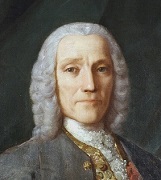 Domenico Scarlatti was a contemporary of both Handel and Bach, all being born in the same year 1685. He was born in Naples when it was under Spanish rule, and went on to have connections with both Italy and Spain. Domenico was one of the sons of Alessandro Scarlatti (also an accomplished composer), and he studied under his father and other musicians of the time. Indeed sometimes you will see some confusion between Alessandro and Domenico, with some works being listed under the wrong name, possibly because the composer of those works was at one time identified by the surname only. When still in his teens, Domenico became organist at the Chapel Royal of Naples when his father was in charge of the orchestra, and after a few years his father sent him to Venice to continue his studies. Then in Rome he was employed by the exiled Polish Queen, and later he was employed for a few years by the Vatican. It is said that he met Handel while in Rome and the two competed there in a staged duel to demonstrate their keyboard skills, with the main outcome being a mutual respect between the two composers. Then in Lisbon he became musical director to the King of Portugal, and taught music to his daughter the Princess Barbara. Scarlatti himself married and moved to Seville, and then to Madrid to work again for Barbara who by this time had become Queen of Spain upon her marriage to Ferdinand VI. He remained in Spain for the rest of his life and it was in Madrid that most of his famous sonatas were composed.
Domenico Scarlatti was a contemporary of both Handel and Bach, all being born in the same year 1685. He was born in Naples when it was under Spanish rule, and went on to have connections with both Italy and Spain. Domenico was one of the sons of Alessandro Scarlatti (also an accomplished composer), and he studied under his father and other musicians of the time. Indeed sometimes you will see some confusion between Alessandro and Domenico, with some works being listed under the wrong name, possibly because the composer of those works was at one time identified by the surname only. When still in his teens, Domenico became organist at the Chapel Royal of Naples when his father was in charge of the orchestra, and after a few years his father sent him to Venice to continue his studies. Then in Rome he was employed by the exiled Polish Queen, and later he was employed for a few years by the Vatican. It is said that he met Handel while in Rome and the two competed there in a staged duel to demonstrate their keyboard skills, with the main outcome being a mutual respect between the two composers. Then in Lisbon he became musical director to the King of Portugal, and taught music to his daughter the Princess Barbara. Scarlatti himself married and moved to Seville, and then to Madrid to work again for Barbara who by this time had become Queen of Spain upon her marriage to Ferdinand VI. He remained in Spain for the rest of his life and it was in Madrid that most of his famous sonatas were composed.
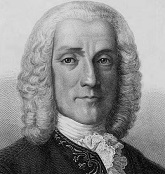 In terms of Scarlatti's music, he is best-known by far as being the composer of 555 keyboard sonatas, although only a few were published (in London) during his lifetime and there could even be more to find. The surviving scores exist only as copies written by royal scribes, and no autograph versions have survived. Most of these sonatas are single-movement works in binary form (i.e. split into two sections). While they mostly follow this template they are extremely varied in character. It is as if the composer was experimenting with different ideas, and seeing how far he could stretch the basic template. Although called "sonatas", most are not in the same extended multi-movement form as the classical sonatas of Haydn and Mozart, but many of the works were conceived as pairs of sonatas in the same or related keys and often in contrasting tempos.
In terms of Scarlatti's music, he is best-known by far as being the composer of 555 keyboard sonatas, although only a few were published (in London) during his lifetime and there could even be more to find. The surviving scores exist only as copies written by royal scribes, and no autograph versions have survived. Most of these sonatas are single-movement works in binary form (i.e. split into two sections). While they mostly follow this template they are extremely varied in character. It is as if the composer was experimenting with different ideas, and seeing how far he could stretch the basic template. Although called "sonatas", most are not in the same extended multi-movement form as the classical sonatas of Haydn and Mozart, but many of the works were conceived as pairs of sonatas in the same or related keys and often in contrasting tempos.
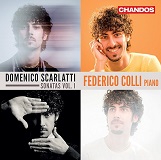 The sonatas cover a rich diversity of styles, with unusual melodic invention, occasional dissonances and some unusual modulations. One sonata might be lively and full of wit, while the next sonata is full of the deepest emotion. Although he lived during the Baroque era, Scarlatti did seem to anticipate a number of musical developments beyond the prevailing Baroque styles. In Scarlatti's day his sonatas would mostly be played on the harpsichord, but there were other keyboards around at the time and it is common practice now to play them on piano. A few of the sonatas are marked for "organ", though they don't have pedal parts so it is not essential to play them on an organ. We previously mentioned the occasional confusion between father and son, though another confusion has arisen in the numbering systems with at least 3 scholars producing catalogues of the sonatas. Most people have settled on the "K" numbering after Kirkpatrick who produced a list in a more understandable chronological order.
The sonatas cover a rich diversity of styles, with unusual melodic invention, occasional dissonances and some unusual modulations. One sonata might be lively and full of wit, while the next sonata is full of the deepest emotion. Although he lived during the Baroque era, Scarlatti did seem to anticipate a number of musical developments beyond the prevailing Baroque styles. In Scarlatti's day his sonatas would mostly be played on the harpsichord, but there were other keyboards around at the time and it is common practice now to play them on piano. A few of the sonatas are marked for "organ", though they don't have pedal parts so it is not essential to play them on an organ. We previously mentioned the occasional confusion between father and son, though another confusion has arisen in the numbering systems with at least 3 scholars producing catalogues of the sonatas. Most people have settled on the "K" numbering after Kirkpatrick who produced a list in a more understandable chronological order.
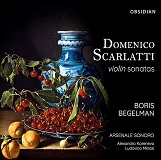 Although we said that Scarlatti's sonatas are mostly single movements, there are a few multi-movement sonatas (mostly with K-numbers in the 60s, 70s, 80s and 90s). This and other factors suggest that they were originally written for solo violin with accompaniment, and some of these have been published as Violin Sonatas. You should not therefore be surprised to find performances and recordings of Scarlatti's "Violin Sonatas". Although some scholars have detected numerous influences from Spanish folk music in Scarlatti's work it doesn't appear that he composed for guitar while in Spain. However some of the sonatas have since been transcribed for guitar. A curious example of his sonatas is the "Cat Fugue" which is listed as K.30 in G minor. This is indeed a fugue and it is said that Scarlatti was inspired to use as a theme the music played by a cat as it walked over a keyboard. The concept of using such random notes as a motif and Scarlatti's Cat Fugue itself has caught the imagination of concert goers, musicians and other composers such as Liszt. The Cat's Fugue and other Scarlatti sonatas also inspired the 20th century Italian composer Vincenzo Tommasini, and he adapted several of the sonatas to create a very successful ballet for Diaghilev called "The Good-Humoured Ladies" (Le donne di buon umore). In some ways this was quite fitting since Scarlatti marked some of the sonatas as "Tempo di ballo" meaning Dance Tempo.
Although we said that Scarlatti's sonatas are mostly single movements, there are a few multi-movement sonatas (mostly with K-numbers in the 60s, 70s, 80s and 90s). This and other factors suggest that they were originally written for solo violin with accompaniment, and some of these have been published as Violin Sonatas. You should not therefore be surprised to find performances and recordings of Scarlatti's "Violin Sonatas". Although some scholars have detected numerous influences from Spanish folk music in Scarlatti's work it doesn't appear that he composed for guitar while in Spain. However some of the sonatas have since been transcribed for guitar. A curious example of his sonatas is the "Cat Fugue" which is listed as K.30 in G minor. This is indeed a fugue and it is said that Scarlatti was inspired to use as a theme the music played by a cat as it walked over a keyboard. The concept of using such random notes as a motif and Scarlatti's Cat Fugue itself has caught the imagination of concert goers, musicians and other composers such as Liszt. The Cat's Fugue and other Scarlatti sonatas also inspired the 20th century Italian composer Vincenzo Tommasini, and he adapted several of the sonatas to create a very successful ballet for Diaghilev called "The Good-Humoured Ladies" (Le donne di buon umore). In some ways this was quite fitting since Scarlatti marked some of the sonatas as "Tempo di ballo" meaning Dance Tempo.
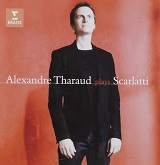 In addition to his sonatas, given that he worked for churches and the Vatican it is not surprising to find that Domenico Scarlatti composed a number of Religious works. Among these are the "Stabat Mater", a Magnificat, a "Te Deum" and Masses such as the Madrid Mass. He wrote a "Salve Regina" for the Queen (thought to be his last composition), and some secular music such as the cantata "Piangete occhi dolenti" (Cry Painful Eyes). Here on mfiles is a small selection of his 555 keyboard sonatas:
In addition to his sonatas, given that he worked for churches and the Vatican it is not surprising to find that Domenico Scarlatti composed a number of Religious works. Among these are the "Stabat Mater", a Magnificat, a "Te Deum" and Masses such as the Madrid Mass. He wrote a "Salve Regina" for the Queen (thought to be his last composition), and some secular music such as the cantata "Piangete occhi dolenti" (Cry Painful Eyes). Here on mfiles is a small selection of his 555 keyboard sonatas:
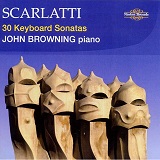 Recordings of Scarlatti's music rightly tend to focus on his Sonatas. There are various selections of these by musicians on piano or sometimes on harpsichord, and for the dedicated fan there are some multi-volume collections of his complete keyboard sonatas. There is also some coverage of his Violin Sonatas:
Recordings of Scarlatti's music rightly tend to focus on his Sonatas. There are various selections of these by musicians on piano or sometimes on harpsichord, and for the dedicated fan there are some multi-volume collections of his complete keyboard sonatas. There is also some coverage of his Violin Sonatas: